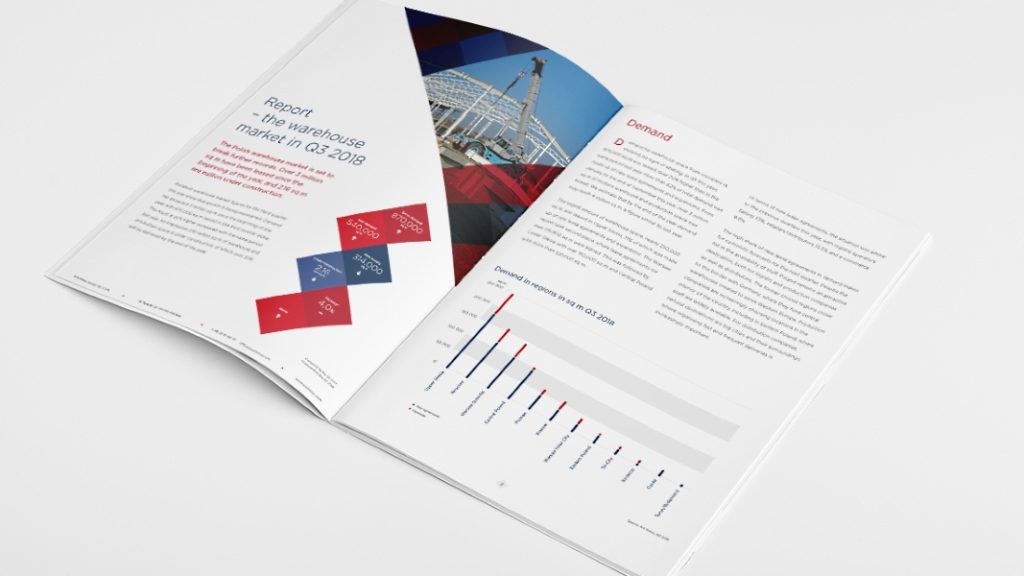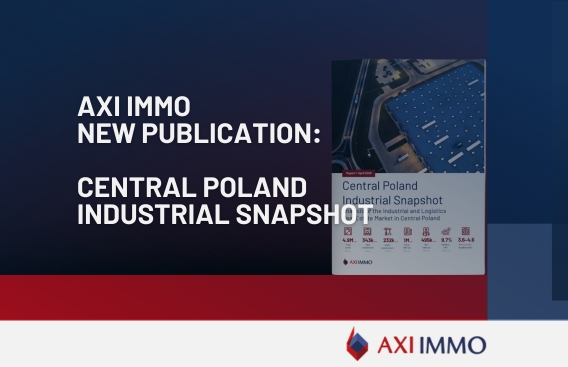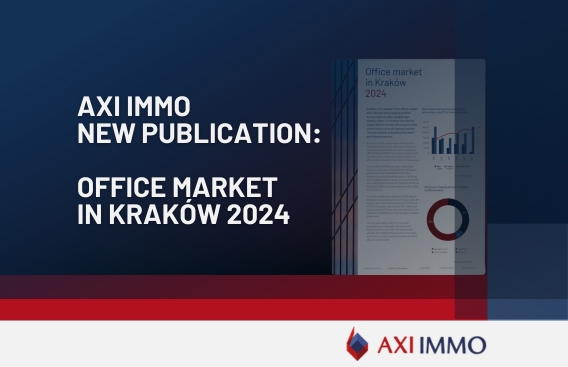Report: Warehouse Market in Q3 2018 in Poland
The latest report - Warehouse market in the Q3 2018 in Poland: The Polish warehouse market on the road for further records. Over 3 million sq m leased from the beginning of the year, 2.16 million is under construction. The Report prepared by AXI IMMO experts.

According to AXI IMMO experts in the latest report, excellent warehouse market figures for the third quarter of this year show that growth is being maintained. Demand has exceeded 3 million sq m since the beginning of the year, with 870,000 sq m leased in the third quarter alone. This result is 20% higher compared with the same period last year. An impressive 2.16 million sq m of warehouse and production space is under construction, of which 33% will be delivered to the market by the end of the year, according to a report – The Warehouse Market in Q3 2018 in Poland.
| Download: | Report Warehouse market in the Q3 2018 in Poland | Download for free: PDF|510 KB |
Demand: upward trend maintained
The demand for warehouse space from occupiers is showing no signs of abating. In Q3 this year, 870,000 sq m was leased, over 20% higher than in the same period last year. More than 62% of total demand was made up of new lease agreements and expansions. From January to the end of September this year, over 3 million sq m of modern warehouse and production space was leased. We estimate that by the end of the year, demand may reach 4 million sq m, a figure similar to last year.
The largest amount of warehouse space, nearly 250,000 sq m, was leased in Upper Silesia, 71% of which was made up of new lease agreements and expansions. The Warsaw region took second place, where lease agreements for over 175,000 sq m were signed. This was followed by Lower Silesia with over 150,000 sq m and Central Poland with more than 100,000 sq m.
In terms of new lease agreements, the situation was similar to the previous quarters this year, with logistic operators taking 33%, retailers/distributors 15.5% and e-commerce 9.8%.
“The high share of new lease agreements in demand makes for optimistic forecasts for the next quarter. Despite the fall in the availability of staff, Poland remains an attractive destination, both for logistic and production companies as well as distributors. The former choose regions closer to the border with Germany, where they have central warehouses created to serve Western Europe. Production companies are increasingly choosing locations in the interior of the country, including in Eastern Poland, where staff are widely available. For distribution companies, natural destinations are big cities and their surroundings, where organising fast and frequent deliveries is increasingly important.” – comments Anna Głowacz, Head of Industrial at AXI IMMO.
Supply: an annual increase of the new area at the level of 2.8 million sq m.
The total supply of modern warehouse space in Poland in Q3 2018 exceeded 15.1 million square meters, which was the result of 1.34 million sq m being completed since the beginning of the year, of which 622,000 sq m were within investments completed in Q3 this year. This result is 29% lower compared with Q3 2017, but still high considering that more than 2.16 million sq m remains under construction.
Developers delivered the most new A-class space on the market in Central Poland (over 210,000 sq m) followed by Upper Silesia (124,000 sq m). Development activity has been highest in these two regions for over a year. Also, worth noting are the high figures for Eastern and Western Poland, where there were 75,000 sq m of modern warehouse space was completed.
The unquestioned leader in terms of the volume of space under construction in Central Poland (566,000 sq m), followed by Upper Silesia (365,000 sq m), Lower Silesia (325,000 sq m) and Warsaw (280,000 sq m).
The share of purpose-built investments is surging ahead at a level close to 20%, but also in comparison to the previous quarter of this year, the share of speculative projects under construction increased, reaching 41% by the end of September.
Vacancy rates – Low availability of space, despite many investments in construction
The average vacancy rate in Q3 this year remained low and at the end of September stood at 4%, which was the same as in the previous quarter this year. However, differences in availability in individual regions vary widely. Most free space for immediate rent was reported in Eastern Poland (9.5%). This is a significant jump, by as much as 7 p.p., compared to the second quarter. Among the main markets, the highest rate was recorded in Warsaw (7.4%), followed by the Poznan region (6.9%). An increase in availability from a six-month perspective can be expected in Lodz. This is where new speculation projects are implemented by Panattoni, Prologis, and Segro.
Rental rates on the further growth path
An increase of 0.1 to 0.3 euro per square meter in rental rates is visible in almost all the country’s warehouse regions. Along with increases in construction costs, including building materials and labor, consolidations in the owner market have also played a role. Strong activity among Asian investment platforms and portfolio purchases in Poland has led to new owners raising the value of their properties and limiting rent holidays and other incentives for tenants.
Currently, the lowest effective rates of around 2.0 euro/sq m are still achievable in Błonie and Grodzisk Mazowiecki near Warsaw. An upward trend is visible in the Wrocław region, Upper Silesia, and selected locations of Central Poland. Meanwhile, rates remain relatively high in new markets, such as Białystok, Szczecin, and Bydgoszcz. Right over there, where average effective rates range from 2.5 to 2.8 euro/sq m.
Forecasts for the warehouse market
The warehouse market will continue to record a path in the coming quarters. We estimate that at the end of the year, demand should reach a similar value of 4 million sq m as in the previous year, the main driver of which will be the e-commerce and retail sectors.
At the end of the year, the total warehouse supply in Poland will exceed 16 million sqm, and the expected annual increase in warehouse space will be around 2.8 million sq m.
Investors are showing a lot of interest in the warehouse sector, which is currently the highest-rated among all asset types in the commercial real estate sector. We will witness further major acquisitions and portfolio purchases in the CEE region and Poland, which may have an additional impact on the increase in rental rates in Poland.
From the long-term perspective, the low availability of staff will push many companies to develop automation tools, which in turn will require developers to adapt their space to the needs of tenants to an even greater extent. The effect of this will be an increased number of BTS investments, with varying technical parameters, for example, buildings over 10 m in height, the above-standard load capacity of floors, mezzanines, and increased demand for utilities.
Read the previous report of AXI IMMO experts for the warehouse market: Report – Warehouse market in the first half of 2018
Recent articles
14 April 2025
New Work expands in Warsaw with new serviced offices space at Metron building, AXI IMMO advises
Serviced offices at New Work in Warsaw, just steps away from Metro Wierzbno station.
9 April 2025
Central Poland Industrial Snapshot – Analysis of the industrial and logistics real estate market in Central Poland, AXI IMMO publication
High industrial take-up in Łódź region in 2024 driven by lease renewals
3 April 2025
AXI IMMO presents its analysis of the industrial & logistics market in Małopolska, southern Poland
Małopolska on developers' spotlight: more space for industrial and logistics on the horizon.
24 March 2025
Office market in Kraków 2024, Poland, publication by AXI IMMO, 2025 March – Analysis, trends, forecasts
Kraków is the leader of regional office markets – tenant activity is growing. AXI IMMO's special publication on Office market in Krakow in 2024, Poland includes an analysis of supply, demand, rental rates, as well as trends and forecasts on the Krakow office market in 2025 and 2026.



